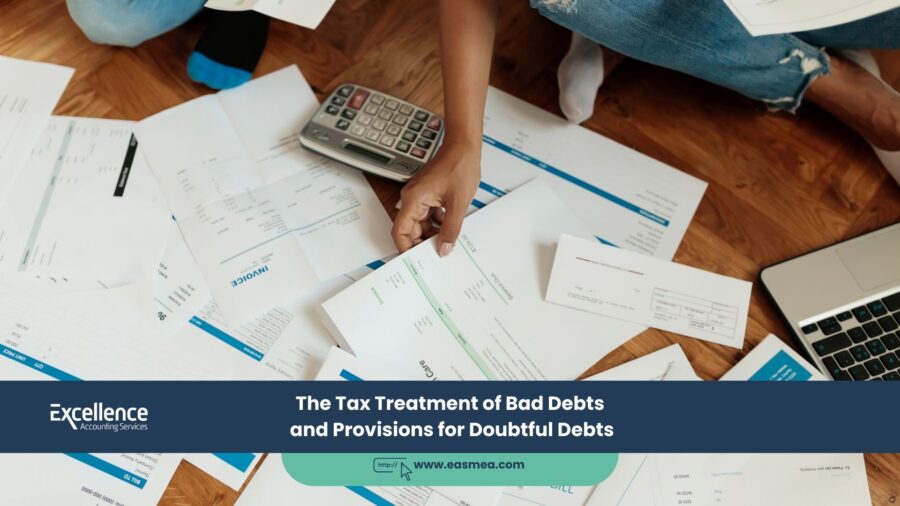A Guide to the Tax Treatment of Bad Debts and Provisions for Doubtful Debts in the UAE
In an ideal world, every invoice issued would be paid on time. In reality, every business that sells on credit faces the risk of non-payment. These uncollectible invoices, known as bad debts, are an unfortunate cost of doing business. From an accounting perspective, businesses plan for this by creating a “provision for doubtful debts.” From a tax perspective, however, the rules are much stricter. You cannot simply get tax relief for a debt you *think* might go bad.
- A Guide to the Tax Treatment of Bad Debts and Provisions for Doubtful Debts in the UAE
- The Accounting Context: Provisions vs. Write-Offs
- Corporate Tax Treatment: When is a Bad Debt Deductible?
- VAT Treatment: Claiming Bad Debt Relief
- Managing Credit and Tax with Excellence Accounting Services (EAS)
- Frequently Asked Questions (FAQs)
- Don't Let Bad Debts Hurt Your Bottom Line Twice.
The introduction of Corporate Tax in the UAE, alongside the existing VAT framework, has created two distinct sets of rules for how bad debts are treated. For Corporate Tax, the question is: “When can I deduct the bad debt as an expense?” For VAT, the question is: “When can I reclaim the VAT I already paid to the FTA on the invoice that was never paid?” Misunderstanding the difference between these rules can lead to incorrect tax filings and disallowed claims.
This guide will provide a clear explanation of the tax treatment for both provisions and bad debts under UAE Corporate Tax and VAT law. We will outline the specific conditions you must meet to claim a deduction or relief and the critical importance of proper documentation.
Key Takeaways
- Provisions vs. Bad Debts: A **provision** is an estimate of future losses and is generally **not** deductible for Corporate Tax. A **bad debt** is a specific debt confirmed as uncollectible and may be deductible.
- Corporate Tax Deduction: A bad debt expense is only deductible for Corporate Tax when it is formally **written off** and the business has taken reasonable steps to collect it.
- VAT Bad Debt Relief: You can reclaim the output VAT on an unpaid invoice only after **6 months** have passed from the due date, you have written the debt off, and you have notified the customer.
- Two Separate Sets of Rules: The conditions for claiming a Corporate Tax deduction and claiming VAT relief are different and must be met independently.
- Documentation is Everything: To claim any deduction or relief, you must have robust documentation proving the debt is bad and that you have made genuine efforts to collect it. This is where professional accounting and bookkeeping is vital.
The Accounting Context: Provisions vs. Write-Offs
First, it’s important to understand the accounting terms.
- Provision for Doubtful Debts: This is an accounting estimate. At the end of a period, a company estimates how much of its Accounts Receivable might not be collected. This is recorded as an expense on the P&L and reduces the net value of receivables on the balance sheet. It is a forward-looking estimate.
- Bad Debt Write-Off: This is the final step. When a specific invoice is confirmed to be uncollectible (e.g., the customer has gone bankrupt), it is removed (“written off”) from the Accounts Receivable ledger. This is a recognition of a confirmed loss.
Corporate Tax Treatment: When is a Bad Debt Deductible?
The UAE Corporate Tax law is very clear: a general provision for doubtful debts is **not a deductible expense**. You cannot reduce your taxable profit based on a general estimate of potential future losses.
A specific bad debt can be deducted as an expense, but only when it is formally **written off**. To be eligible to claim the deduction, you must be able to demonstrate to the FTA that:
- The debt was included in your taxable income when it was created (i.e., you used accrual accounting).
- You have taken reasonable steps to pursue payment of the debt.
- You have formally written the debt off in your accounting records.
The term “reasonable steps” is not explicitly defined and depends on the circumstances, but it would typically include sending reminder letters, making follow-up calls, and potentially initiating legal action or engaging a debt collection agency.
VAT Treatment: Claiming Bad Debt Relief
When you issue a tax invoice, you are required to declare and pay the 5% output VAT to the FTA in that tax period, regardless of whether you have been paid by your customer. If the customer never pays, you are left out of pocket for the VAT. The “Bad Debt Relief” mechanism allows you to reclaim this VAT, but only if you meet **all** of the following four conditions:
- You have made a taxable supply of goods or services and have accounted for the output VAT.
- More than **six (6) months** have passed since the date the payment was due.
- You have written the debt off in your books as a bad debt.
- You have notified the debtor (your customer) of your intention to write off the debt.
If you meet all these conditions, you can make a downward adjustment in Box 7 of your next VAT return for the amount of VAT you are reclaiming.
| Aspect | Corporate Tax Deduction | VAT Bad Debt Relief |
|---|---|---|
| What can be claimed? | The net value of the invoice (the expense). | The 5% VAT amount on the invoice. |
| Key Condition | Debt is written off after “reasonable steps” to collect. | Debt is written off AND is more than 6 months overdue. |
| Provisions Deductible? | No | Not applicable. |
| Timing | In the tax period the debt is written off. | In the tax period all conditions (including the 6-month rule) are met. |
Managing Credit and Tax with Excellence Accounting Services (EAS)
Effectively managing bad debts for tax purposes requires a combination of robust credit control and precise accounting. EAS provides the expertise to ensure you are compliant and can claim all eligible relief.
- Credit Control Policy Development: As part of our CFO services, we help you design and implement a credit control policy that includes clear steps for chasing overdue payments, providing the evidence needed for a bad debt write-off.
- Expert Bookkeeping: Our team ensures that provisions and bad debt write-offs are correctly recorded in your books, creating a clear audit trail.
- Tax Return Filing: We manage both your VAT return filing and Corporate Tax filing, ensuring that any bad debt deductions or VAT relief claims are made correctly and at the right time.
- FTA Audit Support: We can defend your bad debt claims during a tax audit, backed by the robust documentation and processes we help you establish.
Frequently Asked Questions (FAQs)
This is a judgment call, but it must be a genuine effort. It would typically include a documented process of sending multiple reminders, making phone calls, sending a final demand letter, and, for larger amounts, considering legal action. You need to be able to prove to the FTA that you didn’t simply give up on the debt.
A formal email or letter is sufficient. It should clearly state the invoice number, the amount, and that you are now writing this amount off as a bad debt in your books. You must keep a copy of this notification as proof.
You must reverse the relief/deduction. For VAT, you must make an upward adjustment in your next VAT return for the VAT amount you recovered. For Corporate Tax, the recovered amount would be treated as taxable income in the period it is received.
Yes. If a customer has paid part of an invoice but defaulted on the rest, you can claim bad debt relief on the unpaid portion, provided all other conditions are met for that portion.
It starts from the date the payment was due, as stated on the invoice or in your contract.
This is a high-risk area and will be scrutinized heavily by the FTA. You would need to provide very strong evidence that you took the same rigorous steps to collect the debt as you would for an independent third party. A simple write-off without genuine collection efforts will likely be disallowed.
Because they are just an estimate and not a realized loss. Tax deductions are generally only allowed for expenses and losses that have actually been incurred. A general provision is a prudent accounting measure, but it is not a confirmed financial loss.
There is no official FTA format, but you should have a clear internal record. This could be a “Bad Debt Write-Off Approval Form” that is signed by management and details the customer, the invoice, the amount, the steps taken to collect, and the final reason for the write-off.
If there is a genuine dispute over the quality of the goods or services, it may not be a “bad debt” but rather a credit issue. The correct procedure would be to issue a credit note to resolve the dispute. Bad debt relief is intended for situations where the customer is unable or unwilling to pay an undisputed invoice.
Not necessarily. The steps should be proportionate to the size of the debt. For a small debt, a clear trail of reminder emails and a final demand letter would likely be considered “reasonable.” For a very large debt, the FTA would expect to see more significant action, such as engaging a lawyer or collection agency.
Conclusion: The Importance of Process and Proof
The ability to get tax relief on bad debts is a crucial concession for businesses, but it is not automatic. Both the Corporate Tax and VAT laws place the burden of proof squarely on the taxpayer. To successfully claim a deduction or relief, you must move beyond simply having an overdue invoice. You need a robust, documented process for credit control and a clear, formal procedure for writing off debts when all collection efforts have failed. In the eyes of the tax authority, a debt is not bad until you can prove you’ve done your best to make it good.
Don't Let Bad Debts Hurt Your Bottom Line Twice.
Contact Excellence Accounting Services for expert guidance on managing bad debts for both Corporate Tax and VAT compliance.




